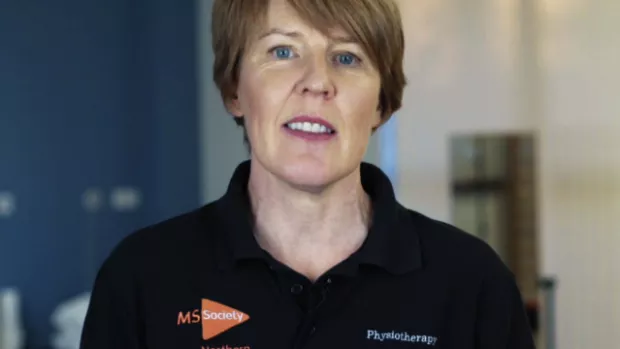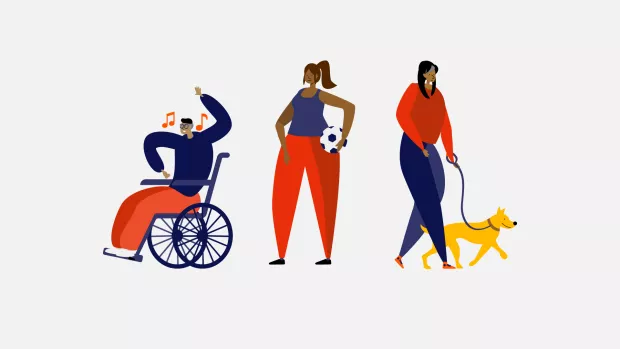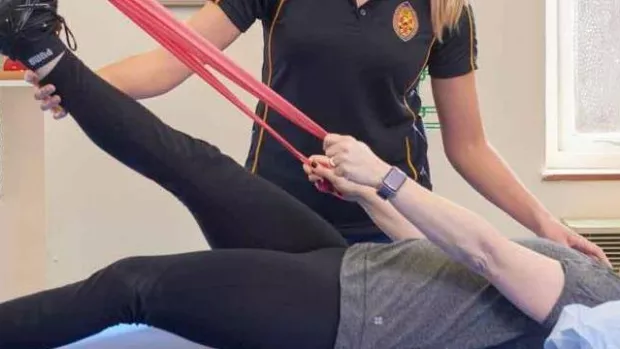
Treating spasms and stiffness
Some people with MS don’t think their spasms or stiffness are major problems. But it’s still a good idea to let your doctor or MS nurse know about them.
The effects of spasms and stiffness vary widely. So treatment needs to be tailored to your own needs and abilities. And talking about your issues will help your healthcare professionals find the right treatments for you. And it might avoid complications in the future.
Healthcare professionals will assess your spasms or stiffness and take into account the nature of your symptoms. They'll also look at possible trigger factors making them worse and – very importantly – the impact they have on your daily life.
Exercises to help with muscle spasms
We've worked with physiotherapist Ruth to create a series of simple exercises for muscle spasms. You can do the exercises at home without any special equipment.
Listen to the audio described version on YouTube
Watch our film below to find out how the exercises helped Sylvia and how they could help you, too.
Treatment options
Physiotherapy
Your health team might recommend:
- Range of motion exercises – exercises designed to help you keep maximum movement in a joint may reduce muscle stiffness and prevent stiff joints from lack of use.
- Stretching - stretching muscles can also help prevent long-term complications.
- Strengthening - can help prevent weakness in muscles which can make daily activities and moving about more difficult.
- Light pressure or stroking (touching the muscle may calm the message pathways and relax the muscle, allowing you to stretch or move a little further) .
- Complementary therapies or meditation to help you relax.
Your doctor or MS nurse can refer you to a specialist physiotherapist.
Drug treatments including muscle relaxants
While movement, through physiotherapy and exercise, is important in managing stiffness due to MS, they are sometimes not enough on their own.
Drug treatments can often help, especially when used together with physiotherapy. There are many different drugs used in the treatment of spasticity. All drugs have side effects, and your doctor will talk through the pros and cons of using these drugs.
Baclofen (Lioresal, Lyflex)
A muscle relaxant that can reduce the number of spasms and levels of muscle stiffness.
Tizanidine (Zanaflex)
A muscle relaxant can reduce stiffness and spasms and may be particularly useful to treat painful night-time spasms.
Because its effects last for only 3-6 hours, it can be best used around specific times when relief from symptoms is most important, for example at bedtime.
Gabapentin (Neurontin)
An anticonvulsant drug that calms overactive messages in the central nervous system that might cause spasms.
This drug is not used as commonly as baclofen or tizanidine to treat spasms and stiffness in MS, but it can be a suitable option for some
Dantrolene sodium (Dantrium)
This drug works directly on muscles, reducing their ability to contract.
Diazepam and clonazepam
Diazepam is a muscle relaxant that can reduce stiffness and spasms.
Because of side effects at higher doses, it may be more useful at night. Diazepam is no longer widely used to treat MS spasms and stiffness, but can help some people if other treatments have not worked.
Clonazepam is similar but may be particularly effective for night time spasms.
Both drugs are 'benzodiazepines' - a type of drug that can be addictive with long-term use, so should not be taken for too long.
Baclofen pump (intrathecal baclofen)
Baclofen is supplied continuously to the fluid around the spinal cord. A pump that is surgically implanted near the waistline controls the dose. This system is known as 'intrathecal' injection.
For those with more severe spasms or stiffness, who do not gain adequate benefit from tablet medications, this can be helpful.
By delivering the drug directly to the area in which it works, it can be more effective. Because of this, doses can be kept lower, keeping side effects to a minimum.
Liquid phenol (intrathecal phenol)
Phenol is injected directly into the fluid around the spinal cord ('intrathecally'). It can be helpful for some people to treat very severe spasms that do not respond to physiotherapy and other drug treatments. Phenol destroys the nerves that control sensation and movement, so it is only used where a person already has limited control of these parts of their body.
Sativex
Sativex is a cannabis-based drug for treating uncontrolled muscle movements (spasm) and muscle stiffness (together known as ‘spasticity’). Sativex is an oral spray containing ‘cannabinoid’ chemicals taken from cannabis plants. It’s sometimes called nabiximols.
Sativex works on the cannabinoid receptors in the brain and spinal cord. You start off taking one dose a day slowly adding more doses (but no more than 12 a day) until you get the most relief from your symptoms.
Can I get Sativex?
In late 2019 the National Institute for Health and Clinical Excellence (NICE), who recommend which drugs are available on the NHS, decided that Sativex could be given to people in England (it was already available in Wales). You have to have ‘moderate’ to ‘severe’ spasticity and other treatments have failed to help. In April 2021 Sativex became available in Northern Ireland, then in September 2022 also in Scotland, under the same conditions as in England.
Where Sativex is available on the NHS, it may still not be easy to get it. That’s because the NHS in some regions might not agree to pay for it the drug or local prescribers decide not to give it to people.
Is Sativex effective?
Around half of the people who took Sativex in one trial found their symptoms were reduced by 20% within four weeks. In those people that Sativex works for there’s a significant improvement in symptoms. If the drug doesn’t have an effect after four weeks treatment is usually stopped.
Some people say Sativex helps not just with muscle spasms and stiffness (spasticity), but also with pain and other symptoms. But this drug will only be routinely prescribed to treat spasticity.
What are the side-effects?
Side-effects include feeling sick, sleepy, dizzy, tired or having diarrhoea, headaches or a dry mouth. Some people report a feeling similar to the ‘high’ you get from smoking cannabis. Side-effects tend to get less after a few weeks and can be reduced by taking fewer doses. It can cause soreness in the mouth. This can be avoided by changing the part of your mouth you spray on.
Sativex shouldn’t be used if you’re pregnant or breastfeeding, under 18 or have had certain serious mental health problems.
You can still drive if you use Sativex, but not when it’s making you feel sleepy, dizzy, or is affecting your concentration or eyesight. This goes for other dangerous activity like operating machinery.
For some people cannabis causes problems with memory or mental health. Sativex doesn’t have these problems – and you can’t become dependent on it.
Aids and equipment
There is a range of equipment which might be helpful - ask a physiotherapist, nurse or occupational therapist if you think the techniques below might benefit you.
- Braces and splints for stretching 'locked' muscles
- Standing frames can stretch the muscles by standing, even if normally this would be difficult or impossible.
- Specially designed beds and chairs can help some people find a suitable posture or by using placing pillows or cushions where needed.
- Correct positioning and support for the body when sitting or lying down can also help you avoid your skin rubbing and causing sores, and prevent aches and pains that can come from poor posture.
Electrical stimulation therapies
Used in combination with drug treatments, some people find electrical stimulation therapies useful. These therapies use electrical impulses to stimulate the muscles and nerve fibres affected by spasticity.
Access to these kinds of therapies varies around the country. Your doctor, physiotherapist or MS nurse can refer you to an appropriate service.
Functional electrical stimulation (FES)
A device that stimulates the muscles and nerve fibres of the ankle and foot, called functional electrical stimulation (often known as FES) can help to combat ‘drop foot’. This is where the muscles can’t smoothly control the foot’s actions during walking.
TENS (Transcutaneous electrical nerve stimulation)
This is another form of electrical stimulation that is applied through pads attached to the surface of the skin. TENS machines may help control the pain that some people experience with muscle spasms.
TENS is based on principles similar to those of acupuncture – that stimulation of the nerves can affect the way pain signals get through to the brain, potentially easing the pain that is felt. It may be particularly useful for managing the pain of spasms at night, especially if these spasms disrupt sleep.
Surgery for severe spasms
Occasionally, orthopaedic surgery and neurosurgery can help restore movement and posture, or can be used to relieve severe, ongoing spasms.
See the booklet 'Muscle spasms and stiffness' for more information



